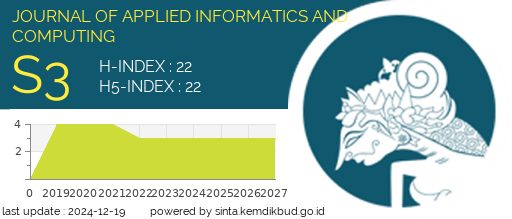Implementation of YOLO v11 for Image-Based Litter Detection and Classification in Environmental Management Efforts
DOI:
https://doi.org/10.30871/jaic.v9i3.9213Keywords:
YOLO v11, Object Detection, Junk, AppsAbstract
This research implements YOLO v11 for image-based waste detection and classification to improve waste management efficiency. The model recognizes four categories of waste: inorganic, organic, hazardous and residual. The training results showa [email protected] of 0.989 and a maximum F1 of 0.98 at an optimal confidence level of 0.669. The model had high precision on the Organic (0.995) and B3 (0.991) classes, but faced difficulties in classifying the Residue category. The confusion matrix revealed most of the predictions were accurate, despite some misclassification. The model also showed stable performance under various lighting and background conditions. With this reliability, YOLO v11 can be applied in automated sorting systems to improve recycling efficiency and support sustainable environmental management, although further improvements to data augmentation and class weight adjustment are still needed.
Downloads
References
[1] M. S. Nafiz, S. S. Das, M. K. Morol, A. Al Juabir, and D. Nandi, “ConvoWaste: An Automatic Waste Segregation Machine Using Deep Learning,” Int. Conf. Robot. Electr. Signal Process. Tech., vol. 2023-Janua, pp. 181–186, 2023, doi: 10.1109/ICREST57604.2023.10070078.
[2] M. G. V. Kumar, M. Kumar, K. N. Rao, P. S. Rao, A. Tirumala, and E. Patnala, “Advanced YOLO-Based Trash Classification and Recycling Assistant for Enhanced Waste Management and Sustainability,” 2nd Int. Conf. Intell. Cyber Phys. Syst. Internet Things, ICoICI 2024 -Proc., no. September, pp. 1238–1246, 2024, doi: 10.1109/ICoICI62503.2024.10696214.
[3] R. Sasaki, M. Fujinami, and H. Nakai, “Comprehensive image dataset for enhancing object detection in chemical experiments,” Data Br., vol. 52, p. 110054, 2024, doi: 10.1016/j.dib.2024.110054.
[4] B. A. Yolv, D. Adriansyah, M. Pajar, and K. Putra, “Sistem Deteksi Objek Visual Sampah Organik Dan Anorganik,” vol. 6, no. 2, pp. 0–9, 2025, doi: 10.47065/josh.v6i2.6454.
[5] E. Z. Kuang, K. R. Bhandari, and J. Gao, “Optimizing Waste Management with Advanced Object Detection for Garbage Classification,” 2024, [Online]. Available: http://arxiv.org/abs/2410.09975
[6] B. D. Prasetya, E. P. Amalia, and P. D. Juliana, “Implementasi Object Detection Berbasis Web untuk Klasifikasi Jenis Sampah Menggunakan YOLOv8,” vol. 4, pp. 60–65, 2025.
[7] N. Crasto, “Class Imbalance in Object Detection: An Experimental Diagnosis and Study of Mitigation Strategies,” vol. 5, 2024, [Online]. Available: http://arxiv.org/abs/2403.07113
[8] A. I. Pradana, “Deteksi Rambu Lalu Lintas Real-Time di Indonesia dengan Penerapan YOLOv11 : Solusi Untuk Keamanan Berkendara,” pp. 145–155, 2024, doi: 10.33364/algoritma/v.21-2.2106.
[9] M. Al-husaini, A. R. Raharja, V. Hafizh, C. Putra, and H. Hen, “Journal of Computer Networks , Architecture and High Performance Computing Enhanced Plant Disease Detection Using Computer Vision YOLOv11 : Pre-Trained Neural Network Model Application Journal of Computer Networks , Architecture and High Performance Comp,” vol. 7, no. 1, pp. 82–95, 2025.
[10] H. D. Kahingide and A. Salam, “Deployment of Kidney Tumor Disease Object Detection Using CT-Scan with YOLOv5,” J. Appl. Informatics Comput., vol. 8, no. 1, pp. 98–105, 2024, doi: 10.30871/jaic.v8i1.7771.
[11] Q. Zhang, Q. Yang, X. Zhang, Q. Bao, J. Su, and X. Liu, “Waste image classification based on transfer learning and convolutional neural network,” Waste Manag., vol. 135, no. May, pp. 150–157, 2021, doi: 10.1016/j.wasman.2021.08.038.
[12] A. Aprilla, W. Prihartono, C. L. Rohmat, and K. Kunci, “Optimasi Model Klasifikasi Citra Sampah Daur Ulang Dengan Algoritma Yolo11,” J. KHATULISTIWA Inform., vol. 12, no. 2, pp. 92–97, 2024.
[13] R. Khanam and M. Hussain, “YOLOv11: An Overview of the Key Architectural Enhancements,” vol. 2024, pp. 1–9, 2024, [Online]. Available: http://arxiv.org/abs/2410.17725
[14] D. Waskito, D. F. Syarifah, and R. A. Aprilianto, “Comparison of the Use of YOLOv11 Variations in the Empty Parking Spaces Detection System,” vol. 23, no. 1, pp. 1–10, 2025.
[15] W. Liu et al., “Future climate change significantly alters interannual wheat yield variability over half of harvested areas,” Environ. Res. Lett., vol. 16, no. 9, 2021, doi: 10.1088/1748-9326/ac1fbb.
[16] J. Fritsch, T. Kuhnl, and A. Geiger, “A new performance measure and evaluation benchmark for road detection algorithms,” IEEE Conf. Intell. Transp. Syst. Proceedings, ITSC, no. November, pp. 1693–1700, 2013, doi: 10.1109/ITSC.2013.6728473.
Downloads
Published
How to Cite
Issue
Section
License
Copyright (c) 2025 Lingga Kurnia Ramadhani, Bajeng Nurul Widyaningrum

This work is licensed under a Creative Commons Attribution-ShareAlike 4.0 International License.
Authors who publish with this journal agree to the following terms:
- Authors retain copyright and grant the journal right of first publication with the work simultaneously licensed under a Creative Commons Attribution License (Attribution-ShareAlike 4.0 International (CC BY-SA 4.0) ) that allows others to share the work with an acknowledgement of the work's authorship and initial publication in this journal.
- Authors are able to enter into separate, additional contractual arrangements for the non-exclusive distribution of the journal's published version of the work (e.g., post it to an institutional repository or publish it in a book), with an acknowledgement of its initial publication in this journal.
- Authors are permitted and encouraged to post their work online (e.g., in institutional repositories or on their website) prior to and during the submission process, as it can lead to productive exchanges, as well as earlier and greater citation of published work (See The Effect of Open Access).











